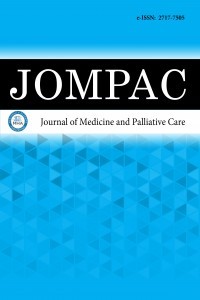Yoğun bakım SARS-CoV-2 hastalarında santral venöz katetere bağlı tromboz insidansı ve risk faktörleri
Covid-19, Femoral Vein, SARS-COV-2, Thrombosis, Intensive Care, COVID -19, femoral vein, intensive care, SARS-COV-2, thrombosis
The incidence and risk factors of thrombosis due to central venous catheter in SARS-CoV-2 patients in intensive care
COVID -19, femoral vein, intensive care, SARS-COV-2, thrombosis,
___
- Berlin DA, Gulick RM, Martinez FJ. Ciężki COVID-19. N Engl J Med 2020; 383: 2451-60.
- Kashi M, Jacquin A, Dakhil B, et al. Severe arterial thrombosis associated with COVID COVID-19 infection. Trombosis Research 2020; 192: 75-7.
- Henry BM, Vikse J, Benoit S, Favaloro EJ, Lippi G. Hyperinflammation and derangement of renin-angiotensin-aldosterone system in COVID-19: a novel hypothesis for clinically suspected hypercoagulopathy and microvascular immunothrombosis. Clinica chimica acta 2020; 507: 167-73.
- Spiezia L, Boscolo A, Poletto F, et al. COVID-19-related severe hypercoagulability in patients admitted to intensive care unit for acute respiratory failure. Thromb Haemost 2020; 120: 998-1000.
- Forauer AR, Theoharis CG, Dasika NL. Jugular vein catheter placement: histologic features and development of catheter-related (fibrin) sheaths in a swine model. Radiology 2006; 240: 427-34.
- Liangos O, Gul A, Madias NE, Jaber BL. Long-term management of the tunneled venous catheter. Semin Dial 2006; 19: 158-64.
- Tayebi P. Jugular vein catheterization in critically ill patients with corona virus disease 2019 can increase the surgeon’s exposure. Vasc Specialist Int. 2020; 36: 201–2.
- Scoppettuolo G, Biasucci DG, Pittiruti M. Vascular access in COVID-19 patients: Smart decisions for maximal safety. The Journal of Vascular Access. 2020; 21: 408-10.
- Geerts W. Central venous catheter-related thrombosis. Hematology Am Soc Hematol Educ Program. 2014; 1: 306-11.
- Monreal M, Raventos A, Lerma R, et. al. Pulmonary embolism in patients with upper extremity DVT associated to venous central lines—a prospective study. Thromb Haemost 1994; 72: 548-550.
- Chopra V, Anand S, Hickner A, et. al. Risk of venous thromboembolism associated with peripherally inserted central catheters: a systematic review and meta-analysis. Lancet 2013; 382: 311-25.
- Grant JD, Stevens SM, Woller SC, et. al. Diagnosis and management of upper extremity deep-vein thrombosis in adults. Thromb. Haemost 2012; 108: 1097-108.
- Akoğlu H, Yılmaz R, Peynircioğlu B, et al. A rare complication of hemodialysis catheters: Superior vena cava syndrome. Hemodialysis Inter 2007;1 1: 385-91.
- Gray BH, Olin JW, Graor RA, Young JR, Brtholomew JR, Ruschhaupt WF. Safety and efficacy of thrombolytic therapy for superior vena cava syndrome. Chest 1991; 99: 54-9.
- Romano L, Bilotta F, Dauri M, et al. Short Report- Medical nutrition therapy for critically ill patients with COVID -19. Eur Rev Med Pharmacol Sci. 2020; 24: 4035-9
- Rooden CJ, Tesselaar ME, Osanto S, Rosendaal FR, Huisman MV. Deep vein thrombosis associated with central venous catheters- a review. J Thromb Haemost. 2005; 3: 2409-19.
- Kreuziger LB, Jaffray J, Carrier M. Epidemiology, diagnosis, prevention and treatment of catheter-related thrombosis in children and adults. Thromb Research 2017; 157: 64-71.
- Frank D.A., Meuse J., Hirsch D., Ibrahim J.G., Van den Abbeele A.D.: The treatment and outcome of cancer patients with thromboses on central venous catheters. J. Thromb. Thrombolysis 2000; 10: 271-5.
- Farge D, Bounameaux H, Brenner B, et al. International clinical practice guidelines including guidance for direct oral anticoagulants in the treatment and prophylaxis of venous thromboembolism in patients with cancer. Lancet Oncol 2016; 17: e452-e466.
- Yosunkaya A, Çelik JB, Dayıoğlu M, Erkoçak R, Paksoy Y. Santral ven kateterizasyonuna bağlı tromboz ve superior vena kava sendromu. Türk Anest Rean Der Derg 2009; 37: 108-13.
- Başlangıç: 2020
- Yayıncı: MediHealth Academy Yayıncılık
Obezite geliştirme riskini öngörebilecek bazı ölçüm parametrelerinin analizi: klinik bir çalışma
Sercan BULUT ÇELİK, Pakize Gamze ERTEN BUCAKTEPE, Ülkü BULUT BATUR, İbrahim Umud BULUT
Jülide SAYİN KART, Ummahan DALKİLİNC HOKENEK
Hüseyin Furkan ÖZTÜRK, Gonca ALTINIŞIK İNAN, İpek Pınar ARAL, Suheyla AYTAÇ ARSLAN, Sedef GÖKHAN AÇIKGÖZ, Havva BEYAZ, Yılmaz TEZCAN
Distal radius torus kırıklarında tedavi maaliyetlerini azaltmak mümkün mü?
Kronik obstrüktif akciğer hastalığında gevşeme egzersizlerinin dispne ve uyku kalitesine etkisi
Hülya IŞIKEL, Sebahat GENÇ, Özge ORAL TAPAN, Özge İPEK DONGAZ
Dilek ERDEM, Figen YARDIMCI, Hacı Bayram YILMAZ, Ali BUHUR
COVID-19, DEHB'li çocuk ve ergenlerin ruh sağlığı ve yaşam kalitesini etkiledi mi?
Abdullah KAHRAMAN, Güler ERASLAN DOĞANAY
Pankreas kanserli hastalarda sağkalıma etki eden prognostik faktörler: tek merkez deneyimi
